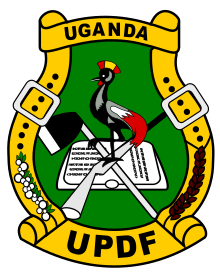| Uganda People's Defence Force | |
|---|---|
 Uganda People's Defence Force emblem | |
 Uganda People's Defence Force flag | |
| Founded | 1962 |
| Current form | 1995 |
| Service branches | Ugandan Land Forces Ugandan Special Forces Command[1] Ugandan Reserve Forces |
| Headquarters | Mbuya Hill, Kampala, Uganda |
| Leadership | |
| Commander-in-Chief | Yoweri Kaguta Museveni |
| Minister of Defence and Veteran Affairs | Jacob Oboth-Oboth[2] |
| Chief of Defence Forces | General Muhoozi Kainerugaba |
| Personnel | |
| Military age | 18 years of age |
| Active personnel | 46,800 (2014)[3] |
| Expenditure | |
| Budget | US$933.6 million (2015)[4] |
| Percent of GDP | 1.2% (2015)[5] |
| Industry | |
| Domestic suppliers | National Enterprise Corporation |
| Foreign suppliers | |
| Related articles | |
| History | Military history of Uganda |
| Ranks | Military ranks of Uganda |
Parliamentary Seats | |
|---|---|
| Seats in the Parliament of Uganda | 10 / 426
|
The Uganda People's Defence Force (UPDF), previously known as the National Resistance Army, is the armed forces of Uganda. From 2007 to 2011, the International Institute for Strategic Studies estimated the UPDF had a total strength of 40,000–45,000, consisting of land forces and an air wing.[6] Recruitment to the forces is done annually.[7]
After Uganda achieved independence in October 1962, British officers retained most high-level military commands.[8] Ugandans in the rank and file claimed this policy blocked promotions and kept their salaries disproportionately low. These complaints eventually destabilized the armed forces, already weakened by ethnic divisions.[8] Each post-independence regime expanded the size of the army, usually by recruiting from among people of one region or ethnic group, and each government employed military force to subdue political unrest.[8]
- ^ Haggai Matsiko, Muhoozi Archived 28 August 2013 at the Wayback Machine, Independent, 2013
- ^ "Stable Uganda is a Peace Exporter, Mwesige Says as Ssempijja Takes Charge of Defence Ministry". SoftPower. 29 June 2021. Retrieved 4 July 2021.
- ^ "World Development Indicators - Google Public Data Explorer". Google.ro. 7 October 2016. Archived from the original on 9 January 2017. Retrieved 8 January 2017.
- ^ "World Development Indicators - Military expenditure (current LCU)". The World Bank. Archived from the original on 8 July 2016. Retrieved 8 January 2017.
- ^ "World Development Indicators - Military expenditure (% of GDP)". The World Bank. Archived from the original on 8 July 2016. Retrieved 8 January 2017.
- ^ IISS Military Balance 2007, 297; IISS Military Balance 2011, 447.
- ^ Anony (1 July 2020). "UPDF General Recruitment 2021-2022 | Apply Now". Admissions. Archived from the original on 2 February 2023. Retrieved 5 February 2021.
- ^ a b c Cite error: The named reference
locwas invoked but never defined (see the help page).